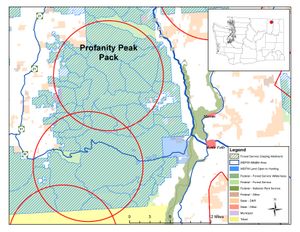Profanity Peak wolf pack details revealed by state; pack removal continues
ENDANGERED SPECIES -- The number of wolves killed from the cattle-attacking Profanity Peak wolf pack in Ferry County has not changed since last week, but Washington Fish and Wildlife Department officials have increased the number of confirmed cattle kills by two.
"Since July 8, the agency has documented 13 depredation events on livestock, including eight confirmed and five probable depredations," Donny Martorello, department wolf program leader, said today.
As state gunners flew in helicopters trying to shoot more members of the 11-wolf pack, a calf was confirmed killed by wolves as recently as Aug. 31.
The Department has lethally removed a total of six wolves, the same number reported in an Aug. 25 update. These include two females removed Aug. 5, and two adult males, one adult female, and one female pup removed Aug. 21-22. The carcasses of all the dead wolves were recovered, Martorello said.
The Profanity Peak pack, one of 19 know wolf packs in Washington, is being eliminated under a protocol hammered out by the various factions in the state's Wolf Advisory Group.
The original action plan called for removing a portion of the pack to see whether cattle attacks would end if there were fewer mouths to feed in a pack that increased by five pups this year. State officials emphasized that lethal removal was a last resort to on-the-ground range rider and operator efforts to deter wolf attacks.
When more cattle attacks were confirmed, WDFW Director Jim Unsworth authorized the extermination of the pack on Aug. 19. Workers in the field said there was no guarantee even with the use of helicopters that all the wolves could be found and killed in the brushy, rugged terrain in the Kettle River Range north of Sherman Pass.
Last week, the Seattle Times ran a story quoting Dr. Rob Wielgus, associate professor and director of the Large Carnivore Conservation Lab at Washington State University, as saying the livestock producer “elected to put his livestock directly on top” of the Profanity Peak wolf den. That stirred things up.
The Times then reported that people involved in wolf research and actions were receiving death threats.
Then, on Aug. 31, WSU issued an apology in a statement disavowing that and other comments made by Wielgus in the Times story.
On Thursday, about 70 people gathered in front of the Department of Natural Resources building in Olympia to protest WDFW’s action to remove the Profanity Peak pack. "The protest, initiated by the Center for Biological Diversity, was peaceful and received some news coverage." Martorello said. CBD is based out of state and is not a member of the state's Wolf Advisory Group, which includes several conservation and wildlife groups.
Following is a list of facts Martorello spelled out to the Wolf Advisory Group regarding the Profanity Peak wolf pack situation.
- Based on field reports of the 13 wolf depredations on livestock since July 8, three were within about a mile of the pack’s activity centers (den or rendezvous sites) and ten ranged from 2 to 10 miles away from wolf activity centers.
- The Profanity Peak pack overlaps almost entirely with federal grazing allotments administered through the U.S. Forest Service. On this range, wolves and livestock share the landscape.
- Four livestock producers operate on the allotments in the area and graze a total of about 1,500 cattle.
- One of the livestock producers set out his cattle (198 pairs of cows-calves) around June 10 in a 30,000-acre allotment, which has only one road access point. The cattle turnout area was four to five miles from the Profanity Peak pack’s den, but the den site wasn’t known or confirmed at the time.
- During the first week of June, Department employees started trapping to place radio collars on Profanity Peak wolves to monitor the pack. There were no collars in this pack prior to that time. We captured and collared an adult male on June 10 and an adult female on June 12.
- As cattle dispersed through the grazing allotment from the release site, the Department employee conducting the trapping noticed cattle starting to come into that area around June 12. In the following weeks biologists began receiving data from those collars, and confirmed the den site by the end of June.
- As cattle continued to disperse through the allotment they inevitably crossed paths with the den site and later with rendezvous sites.
- The Department confirmed the first wolf depredation on July 8. By August 3, the Department had documented four confirmed depredations (and others classified as probable), and the situation met the terms of the lethal removal protocol developed earlier this year. The Director authorized wolf removal actions the same day.
- Following the first depredation July 8, the producer deployed a range rider. The producer also increased human presence on the allotment by hiring two additional people to patrol the area on foot.
- The livestock producers’ U.S. Forest Service grazing permit for this allotment directs them to rotate cattle through multiple allotments over the course of the grazing season. During this time, the paths of wolves and cattle have put the two in close proximity a few times. When such situations occur, the Department works with producers to seek ways to reduce the risk of depredations.
- In one situation, the wolf rendezvous site overlapped with part of the normal grazing path, where livestock were concentrated with the use of salt blocks. Once that overlap was detected, the Department contacted the producer, who removed the salt blocks from the area.
- The Department will continue to communicate and work with the producers to reduce risks of depredations as the situation evolves.

